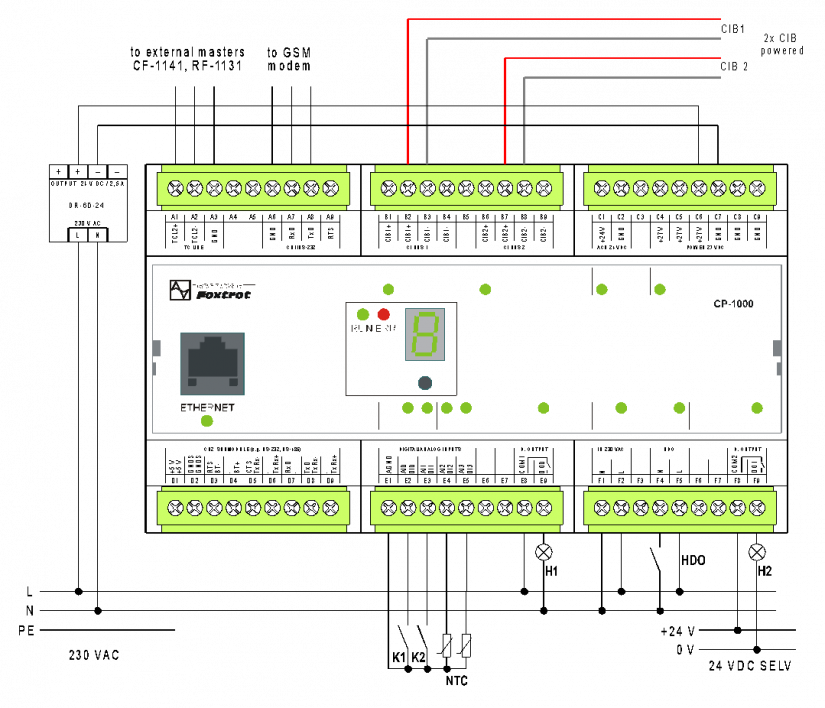The CP-1000 represents the simplest variant of the basic module for home installations.
The basic module is supplied from a 24 VDC source.
Both CIB branches (B connector) are supplied from the basic modules, which means that no decoupling module is used for powering the CIB buses; isolation circuits for power supply to both buses are integrated directly in the CP-1000 basic module.
On the A connector is terminated the system TCL2 bus (primarily for connecting the external CF-1141 and RF-1131) master modules, and the serial communication channel CH1 (usually for GSM modem connection).
On the D connector is terminated the second communication channel, in which additional interfaces can be implemented, such as the RS-485, the M-bus master, CAN, the RS-232 and others, using additional submodules. Possible options of fitting the submodules with interfaces are described in Chapter Communication interface of the Foxtrot basic module.
The E and F connectors serve for inputs and outputs: 4 universal AI/DI (contact, NTC, Pt1000, Ni1000), 2 separate 3 A relay outputs, the ripple control input and IN 230 VAC input (a standard binary 230 VAC input).
The CP-1000xx internal data and time backup during a power failure.
When the power supply for the CP-1000 is interrupted, some selected user data and the real-time clock are backed up. The backup is provided by a Li-Ion battery. After power supply is restored, the battery recharges and is ready to back up again. The battery requires no maintenance.
A Li-Ion battery backup lasts about 500 hours.
Additional internal backup battery
If for some reason you need to extend the backup time (e.g. to bridge the power outage for more than 500 hours), an additional CR2032 lithium battery can be fitted into the prepared holder. After the main battery is discharged, it will start supplying power and thus extend the backup time up to 20,000 hours.
It is recommended to replace the backup battery (the CR2032 or similar, 3 V, 20 mm diameter, 3.2 mm thickness) every 2-3 years. The battery lifetime is typically 5 years. The battery is inserted into the holder located in the middle board of the basic module and it is accessible after removing the boards from the plastic housing (for detailed information see the basic documentation for the individual modules). The battery status is monitored and signalled in the system registers of the basic module.
An additional battery is mounted only if a really long backup time is needed, because the basic module then ceases to be maintenance-free and the battery must be changed regularly.

Fig. .1. An example of power supply connection to the CP-1000 without a backup
Notes:
-
We recommend a stabilized 24 VDC power supply, complying with SELV requirements, and the PS2-60/27 is our standard recommendation. Power consumption of the CP-1000 is the sum of its own power (typically 3 W) and the total power consumption of all CFox modules connected to both CIB branches.
-
In the terminal block B there is an output of both CIB branches including the power supply with a maximum current of 1 A for each branch.
-
The AI/DI0 to AI/DI3 inputs are universal (contact, NTC temperature sensor, Pt1000, Ni1000), the inputs do not have the function of "capturing short pulses", which means that the evaluated input status length must exceed that of the programme cycle (200 ms is usually enough).
-
The IN 230 VAC input (F1 and F2 terminals) is designed to monitor the presence of 230 V mains power supply. It is a standard 230 VAC input, with galvanic isolation.
-
The ripple control input (F4 and F5 terminals) is for the ripple signal coming from the utility distribution grid. This input can withstand - without being damaged - even badly connected ripple control in the household installation.
-
The DO0 and DO1 outputs are standard electromechanical 3 A contact relays, with galvanic isolation from other circuits.
 English
English